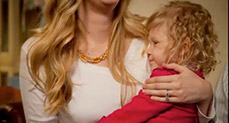Kozie Clothes for Your Child
Have you heard of Kozie Clothes? If you have a child with sensory concerns, a G-Tube or fine motor skill difficulties, this may be your new favorite line of clothing. Founded by a Pediatric Occupational Therapist with a Certification in Sensory Integration and SIPT (Sensory Integration and Praxis Testing), Susan Donohoe worked with a number of professionals before creating Kozie Clothes. What resulted is apparel and products designed for children with special needs.
Apparel includes one-piece baby bodysuits created to adapt to devices such as g-tubes, monitors, leads or I-Vs (under their adaptive medical section), compression clothing, weighted blankets, sensory-sensitive bottoms, tops, skirts and more. Check out their socks – with loops on the top, you can promote your child’s capabilities and independence in getting themselves dressed while also sporting fun designs.
Recently, Kozie Clothes sent out tips for a happy school year with your child. What would you add?
-
- It’s important to keep your children on a morning and evening routine. Use a simple picture schedule; it’s helpful for all children.
- Write a nice note to the teacher describing your child’s issues and ask for a private conference. You don’t want anyone misinterpreting sensory behaviors so let them know what it looks like. It is better to let them know what they may expect. List any accommodations that have worked in school and at home. Don’t forget to list the positives too! Ask them to communicate any issues because you are willing to help.
- In this note, ask for a meeting starting with the primary teacher and don’t forget to reach out to all of the minor subject teachers as well (gym, library, music, art, etc.)
Teacher meeting suggestions:
-
- Suggest starting a communication log
- Come from a positive position appealing to the teacher’s experience. It is easier to make changes from the positive approach than the negative.
- Take responsibility for your part in addressing your child’s behavior as well as involving your child in the responsibility.
- You may need help from an OT, school counselor, etc, to explain your information to teachers who may not be so sensory informed. Try to be patient
- Talk to all the teachers and therapists who will be working with your child to make sure you are all on the same page. For instance, there may be a reason your child can not make eye contact when overloaded in a loud environment or have the need to hold something when there are abrupt changes in their schedule.
- No one knows your child better than you, however remain open to suggestions from others.
- If necessary, don’t be afraid to teach the school to recognize and manage sensory behavior. It will benefit not only your child but all children.
- Be Positive – as your child picks up on your emotions.
How has the transition back into a school schedule gone for your family and kiddos? It can be an adjustment from the excitement and bustle of summer. Share any tips for an easy transition here!
Originally published: September 17, 2013


